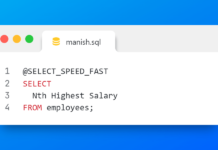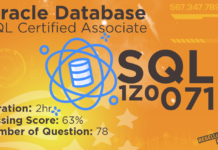As the name suggests Right Outer Join is a form of Outer Join that returns each and every record from the source table and returns only those values from the target table that fulfil the Join condition.
*Note: The Source table is the one situated on the right side of the Right Outer Join Clause whereas The Target table is the one on the left side of this clause.
Syntax :
SELECT
columns
FROM
target_table RIGHT OUTER JOIN source_table
ON(source_table.column = target_table.column)
WHERE condition
ORDER BY column_names;

Examples:
To demonstrate the working of Right Outer Join, I have created two tables by the name of emp and dept and have also inserted some data in them.
Structure of emp table

Structure of dept table

Data in emp table

Have you noticed that in dept table, IT and marketing department don’t have any employees.
Query 1: Right Outer Join with ‘ON’ clause
Now when should we use ON Join Condition in SQL Joins you ask?
When columns which are participating in ON join condition have Different name and Same Data type or
When columns which are participating in ON join condition have SAME NAME and SAME Data-type.
Let’s write a very simple Right outer join query.
SELECT
emp_name, dept_name
FROM dept RIGHT OUTER JOIN emp
ON (emp.EMP_ID = dept.EMP_ID);
In the above query we are selecting emp_name from emp table and dept_name from dept table. Emp table is the source table as it’s on the right hand side of join clause thus automatically making dept table as the target table.
Column emp_id is a primary key in emp table and foreign key in dept table thus column emp_id is the column which is establishing a relationship in between these two tables. As column emp_id is common in both tables thus it’s a best fit for Join condition (ON clause).
If you execute this query you will get all the rows of emp_name column of emp table as emp is the source table and only those rows of dept_name column of dept table which satisfy the join condition (condition in ON clause).
Query 2: Right Outer Join with WHERE clause
You can use WHERE clause with any type of JOIN and limit or Filter the result. In case of JOINS, WHERE clause always comes after Join Condition (ON or USING). Say you want to see employees name and department name whose salary is less than 50,000.
SELECT emp_name, dept_name
FROM dept RIGHT OUTER JOIN emp
ON (emp.EMP_ID = dept.EMP_ID) WHERE emp_salary < 50000;
Query 3: Right Outer Join with USING clause
Using clause can be used in the place of ON clause when
We are performing Equi Join.
We want to put join on that column of source and target table which are common i.e. have same name and data type.
Most of the joins you’ll perform will be equijoins, and if you always use the same name as the primary key for your foreign keys, then:
SELECT emp_name,dept_name FROM dept RIGHT OUTER JOIN emp USING (emp_id);
That’s all on Right Outer Joins. You can also watch my tutorial for understanding its practical usage. Kindly please share this article on your social network and spread the knowledge.
Thanks & Have A Great Day!










